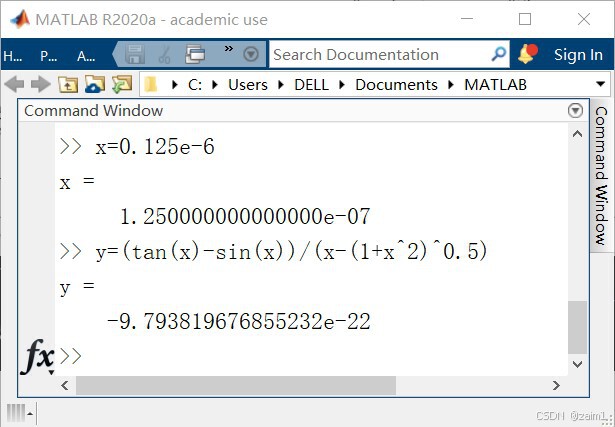目录
1 序言
2 Monte Carlo法计算积分
3 最优化计算Monte Carlo法
1 序言
蒙特卡罗方法(Monte Carlo)是由冯诺依曼和乌拉姆等人发明的,“蒙特卡罗”这个名字是出自摩纳哥的蒙特卡罗赌场,这个方法是一类基于概率的方法的统称。是一种应用随机数来进行计算机模拟的方法,此方法随研究的系统进行随机观察抽样,通过对样本值的观察统计,求得所研究系统的某些参数。
2 Monte Carlo法计算积分
考虑二重积分
根据其几何意义,它是以f(x,y)为曲面顶,A为底的柱体C的体积。用下列简单思路求的近似值:假设C被包在几何体D的内部,D的体积已知,若在D内产生1个均分布的随机数,那么
P(随机数落在C内)C的体积/D的体积
现用Monte Carlo法计算:
% Monte Carlo Integration for f(x, y) = sqrt(1 - x^2) over x^2 + y^2 <= 1
clc; clear;
% Number of random points
N = 1e6; % You can increase this for better accuracy
% Initialize sum of function values
f_sum = 0;
% Loop to generate random points and calculate contributions
for i = 1:N
% Generate random (x, y) within the bounding box [-1, 1] x [-1, 1]
x = -1 + 2*rand(); % Random x in [-1, 1]
y = -1 + 2*rand(); % Random y in [-1, 1]
% Check if the point is inside the circle
if x^2 + y^2 <= 1
f_sum = f_sum + sqrt(1 - x^2); % Accumulate the function value
end
end
% Calculate area of the bounding box
A_box = 4; % The bounding box [-1, 1] x [-1, 1]
% Calculate the integral estimate
integral_value = A_box * f_sum / N;
% Display result
fprintf('Estimated value of the integral: %.6f\n', integral_value);2.1 代码解释:
1)随机点生成:
- 在 [−1,1]×[−1,1] 内均匀生成随机点。
- 使用条件
筛选落在单位圆内的点。
2)函数值累加:
- 对满足条件的点,计算
并累加到
f_sum。
3)积分估计公式:
- 估计积分值为:

- 这里的区域面积 Abox=4 是整个采样的矩形面积。
4)效率:
- N越大,估计值越准确。
- 通过筛选
,只在实际目标区域内计算函数值。
2.2 运算结果
| N = 1e2 | 2.655043 |
| N = 1e4 | 2.685272 |
| N = 1e6 | 2.666568 |
| N = 1e8 | 2.666756 |
3 最优化计算Monte Carlo法
求下列函数的最大值:
为了方便理解,先绘制这个函数:
% Define the function f(x)
f = @(x) (1 - x.^3) .* sin(3 * x);
% Define the range for x
x = linspace(-2*pi, 2*pi, 1000); % Generate 1000 points in the range [-2*pi, 2*pi]
% Compute the function values
y = f(x);
% Plot the function
figure;
plot(x, y, 'b-', 'LineWidth', 1.5);
grid on;
% Add labels and title
xlabel('x');
ylabel('f(x)');
title('Plot of f(x) = (1 - x^3)sin(3x)');
legend('f(x) = (1 - x^3)sin(3x)', 'Location', 'Best');
matlab运行结果如下:
在给出计算代码:
% Optimization using Monte Carlo for f(x) = (1 - x^3) * sin(3x)
clc; clear;
% Number of random samples
N = 1e6; % Increase this for higher accuracy
% Define the function
f = @(x) (1 - x.^3) .* sin(3 * x);
% Generate random samples in the range [-2*pi, 2*pi]
x_samples = -2*pi + (2*pi - (-2*pi)) * rand(N, 1);
% Evaluate the function for each sample
f_values = f(x_samples);
% Find the maximum function value
f_max = max(f_values);
% Find the corresponding x value(s) for the maximum
x_max = x_samples(f_values == f_max);
% Display results
fprintf('Maximum value of f(x): %.6f\n', f_max);
fprintf('At x = %.6f (one of the possible values)\n', x_max(1));
3.1 代码解释
1)随机采样:
- 使用rand(N,1)生成N个均匀分布的随机数映射到区间[-2pi,2pi]中,作为函数的自变量x值。
2)函数评估:
- 定义函数
,计算每个采样点上的函数值
。
3)最大值搜索:
- 使用max函数找到函数值中的最大值
- 找到与最大值对应的x值。
4)输出结果:
- 输出最大值及对应的一个可能的必值(可能有多个全局最大值点)
2.2 运算结果
| N = 1e2 | 191.360411 | 5.858119 |
| N = 1e4 | 194.903941 | -5.814489 |
| N = 1e6 | 194.906195 | -5.816071 |
| N = 1e8 | 194.906195 | -5.816063 |
注:1)本篇内容均为对《MATLAB建模与仿真》(周品 赵新芬 编著,国防工业出版社)摘录与个人归纳总结,如需要更加详细了解,可阅读原书“第8章 随机模拟和统计分析”部分。
2)代码由chat gpt生成。



















![[工具分享] 根据Excel数据根据Word文档模板,批量创建生成Word文档并重命名,方便快速查找打印](https://i-blog.csdnimg.cn/direct/08c579d95a8449cb9391820c694ea7e3.png)